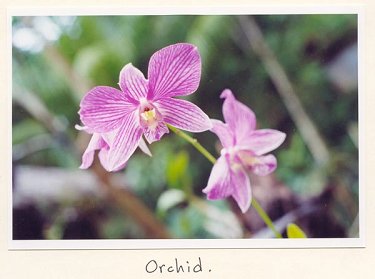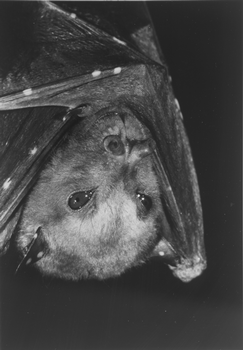|
|
Callan Bentley Philippines |
|
The Research Station
Hiking Up to the Research Station
The next morning it was certain that the typhoon had passed. The dawn was a terrific sunrise at 5:15am. The sky was totally orange, horizon to horizon, highlighted with small horizontal dashes of pink. In the foreground, the black silhouettes of palm trees and fruit bats in flight.
I wasn’t feeling at my best, but since the weather was finally suitable, we made a plan with the two other Peace Corps Volunteers, Jessie and Tasha, to hike up to the rainforest research station. The organization that the three Peace Corps volunteers work for, BioCon, was started with the assistance of a German conservation group, the Frankfurt Zoological Society. FZS maintains a research station high in the interior forest of the island. It is staffed continually by a German, Stefan, and his Ethiopian wife, AmSally. Also often present is June, a Filipino jack-of-all-trades, who keeps the place in good repair and impresses scientists with his common-sense knowledge of the forest. Filipino porters bring supplies up to the station every couple of days, via an arduous forest track. BioCon’s captive dulungans (the more endangered of the two hornbill species) are all kept up at the research station, in hopes of keeping them more habituated to their native habitat. Half of the supplies are for the birds, and half for Stefan and AmSally and whoever else is up at the research station. We picked Jesse and Tasha up, and then drove back up to Cubay. We left the jeep in the care of Lolo and Lola, and then began our trek into the forest. The trail begins at the Bulanao River (running only one way that morning). Almost immediately, my feet were wet. The trail meanders widely, seemingly without regard for the presence of the river. We crossed and recrossed it several times. The water was cool and clear, refreshing, and I had none of the trepidation that I did with our slog through the manure-&-mud trail that we had hiked a couple of days previously. As with our Malumpati nest-hole check-up expedition, we hike through several grades of human-influenced forest before we got into the interior, to the ancient and undisturbed “primary” forest. We did a lot of climbing upwards. Despite the lack of perspective on our surroundings because we were immersed in the forest, it was evident that we were gaining a lot of elevation, at least several thousand feet. I was tired and nursing a cold, and found the hiking more arduous than usual. The cold led to a decreased sense of balance, and twice I slipped and fell. First, I fell down a small cliff, about five feet or so, and stopped myself from plummeting further by jamming my hand into the sharp limestone. While this worked to stop my drop, it also split my thumbnail and scratched up my arm. The second time, I was traversing a downed tree-trunk, several feet above the trail. My feet slid sideways out from under me, and my hip came down hard on the wood. Then, because the trunk was round, my body rolled off and I fell on my other hip a few feet lower, on the ground. The trail led higher and higher into the green. Eventually, it fed into a dry streambed, which was wider and made for easier walking. Noah called it The Highway. We crunched along four abreast, surveying that amazing place. Primary rainforest is an astonishing sight, alive and varied and ragged and mysterious. Surrounding the Highway were giant cycads, plants that are like ferns on steroids. There were elegant curtain-rooted trees all around, draped in vines and mosses. The by-now-familiar crimson forest crabs were here, too, clicking their claws as we passed them by. We heard some tarictics calling up ahead, but couldn’t see them despite pausing for ten minutes to search. We also explored a short cave, and surprised a group of eight fruit bats that were roosting there. Hanging above us, they stared down with charming dog-like faces.
Adventures in the Rainforest
When we finally got to the research station, we had been hiking for five hours. I met Stefan and AmSally and June. Stefan seemed a classically reticent German. AmSally was gorgeous, a Ethiopian fashion queen whose Teutonic hubby had hauled her to the middle of nowhere for two years. June was quiet and reserved, but with a ready smile. Both Noah and Jesse told me, “This guy is amazing.”
I was exhausted: between my head cold, the rigorous trek, and the injuries sustained in my two falls, my body was thoroughly worn out. There was respite at the station though: they served us a fine lunch, and then I took a shower. Philippine resourcefulness had combined with German engineering in the construction of an ingenious outdoor shower. Water from a cold spring was funneled into a bamboo aqueduct, and transported to the station from distant parts of the forest. At the station, the flow could be channeled either into a sink area, or to the shower. The shower stall was made of bamboo as well (as indeed was the entire research station). It was spacious and floored in round gravel pebbles. Above, the water flowed into an empty bleach bottle that had holes punched in the bottom. It was an effective showerhead, and I was delighted to clean up after the long hike. I took a nap until sunset, ate dinner, and fell immediately asleep again. It should give some indication of how tired I was to reveal that despite my arachnophobia, I readily fell asleep in a room that also hosted a spider the size of a dinner plate. We spent two nights at the research station. The following morning, a mild hike brought Noah, Jesse, June, and I to a logged clearing, where we field-tested a new Global Positioning System (GPS) unit. It didn’t work at all. Along the way, we heard wild tarictics and wild dulungans, and even (rarest of the rare) a wild and distant Panay bleeding-heart pigeon. We also saw a large black snake, which June told us was “aggressive” and “crazy.” Noah and I ran into a patch of biting ants, he sustaining a dozen bites, myself only five or so. We waited a while in the clearing, hoping for a GPS satellite to pass overhead. Noah had roasted some peanuts with thyme and garlic and salt, and we snacked on these. There was a small herd of illegal cows grazing in this illegally-logged clearing, and a small lean-to revealed the unseen presence of those who worked here. I felt uneasy in the middle of the clearing, exposed. We found an empty shotgun shell near the shelter. Was there someone out there watching us from beyond the screen of trees? Someone with a shotgun? My companions exhibited none of my fears, and so I left them unspoken. If three men far more habituated to the Philippines than I was saw no reason for alarm, then why should I? We gave up with the GPS and hiked back. We hit a nice rhythm on the return trip, no one talking, just forest-stepping our way along, avoiding roots and rocks (and snakes) on the ground and ducking below vines and thorns and ant-nests above. Noah pointed out some of the nest-boxes that he had constructed and hung high in the rainforest canopy. These nest-boxes were an experiment, an attempt to see if the hornbill population would increase if the number of decent nesting sites increased. Each box was the size of a small refrigerator, wrought from a section of hollow tree-trunk capped at both ends, and a hole precisely the right size drilled in the side. They were decorated in bark and moss, to blend in. I had trouble spotting it when Noah pointed the first one out. I think that it gives an indication of our calorie deprivation that we ate chunks of pineapple smeared in peanut butter for breakfast when we got back. An hour later, our appetites were still raging when AmSally cooked a delicious curry of jackfruit, coconut milk, and ginger. We tried to climb a few trees that afternoon with the technical climbing gear, ostensibly to check on some nest-boxes, but really just to entertain ourselves. I was curious to see what the forest looked like from fifty feet up. Alas, we never made it into the canopy. Our expedition was an ill-fated exercise in futility and frustration. To begin with, we needed to locate the target nest-boxes. Despite the fact that Noah had put them up there in the first place, they proved elusive. He had done a good job camouflaging them. When we finally found one, we went to pull up the climbing rope with a small guide line. The guide line snapped, and we were left trying to toss the line, weighted with a rock, over a branch. Noah had a slingshot for this purpose, but our aim was off. With each miss, we had to gather up the expended line, disentangling it from what seemed like half of the branches in the forest. Every other throw, the rock would come free and sail off into the irretrievable distance. We would then have to hunt for a new rock. It was frustrating, but no one did worse with the set-backs than Noah. I think he really wanted to get up into the trees. He was on the verge of snapping. We broke the tension with some tried-&-true crude American humor. Joking about bodily functions eased the stress, and when we finally gave up and headed back to the station, our good moods had returned. We hiked out of the rainforest the next morning, setting off in a light rain. We took a different trail for our return trip, skirting along the top of a ridge instead of enfolded by trees at the nadir of the valley. This route afforded some stunning views of the surrounding mountains and the broad curve of the sea below. I felt much healthier, and was able to keep up to the quicker pace.
| ||||||||||||||||||

